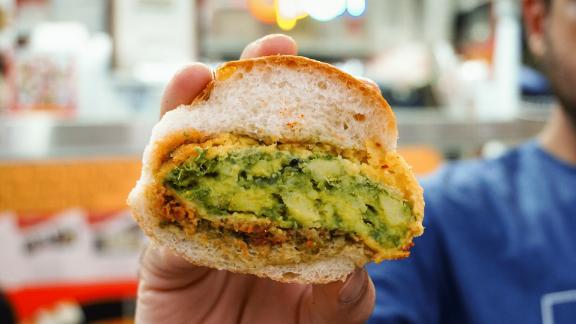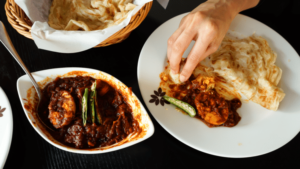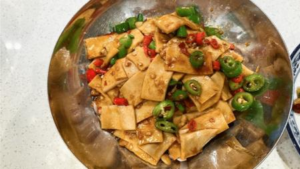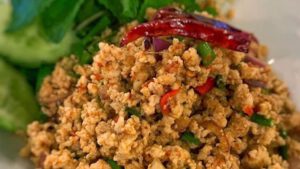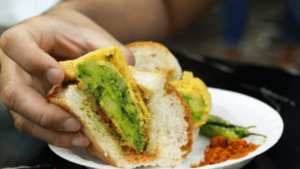These 5 spicy dishes from Dubai are menacingly hot and irresistibly delicious.
Dubai has a strong appetite for heat—not just summer heat, but chilli heat. Through our years of delicious research and food tours across the city’s restaurants, we’ve found ourselves sniffling (or sometimes outright sobbing) over certain dishes that we’ve tasted at Indian, Pakistani, Nepalese, Sri Lankan, Thai, Chinese and Korean restaurants.
There’s undoubtedly a huge spectrum of spice across restaurants, so we turned to two of the deadliest spice warriors we know on the Deep Fried Podcast: Farida Ahmed (our very own GM and tour guide, @faridaa) and Ambika Rajgopal (the founder of the Haute Sauce @hautesauce_dxb range of artisanal hot sauces in the UAE).
Tune in to hear about their favourite chilli-studded dishes which aren’t just dangerously hot, but also irresistibly delicious.
Want more of our scrumptious podcast episodes? Feast on our main podcast page here!
Subscribe on: Apple Podcast App | Spotify (available on AppStore and Google Play) | Google Play Music (currently supported only for listeners in US/Canada) | Anghami
1. Chongqing Noodles 重庆小面 at Chongqing Noodle House
Our general manager and reigning heat queen Farida starts us off with Chongqing-style noodles which “come from the city of Chongqing, which is a mega-city in Southwest China…people traditionally eat these for breakfast.
So, they start off the day on a very spicy note. I mean, that’s a strong start, there’s no going downhill from there. Everything’s only going to go up and it’s usually a vegetarian breakfast dish so, no meat and what really makes it stand out, is the sauce it’s a chili-oily sauce and the way they make it, they use three different types of chili peppers.”
Listen to the podcast or check out the episode transcript to find out how the typical Chongqing chili oil is made.
You can order both the Chongqing Noodles as well as the similarly spicy wontons and more at Chongqing Noodle House in International City.
2. Egg Roast Masala at Nellara Restaurant
Most dishes that make up Malayali Cuisine from Kerala in South India usually pack a double whammy of heat from both chilies and black pepper and are well known for their spiciness. So naturally Ambika’s reply to the waiter’s query on spice level “to go very, very, very spicy as spicy as you can go hit to me” was met with some deserved skepticism.
Fittingly, the “dish arrives and its bright red in color and they definitely went to town on the red chili powder. Now, in addition to the red color, it’s also got a lot of finely diced green chilies. Now in my experience of Indian green chilies, they are notoriously deceptive”
Ambika elaborates on the variable heat of chillies and the limits of the Scoville scale on the podcast or you can also read the transcript to find out more.
Ambika recommends the Egg Roast Masala with flaky Kerala-style Malabar parathas at Nellara Restaurant.
3. Wok Bean Curd 干锅千页豆腐 at Liu Gui Xiang
Ambika’s next pick illustrates this variability of heat quite effectively. Its served at Liu Gui Xiang Restaurant that specializes in cuisine from the Chinese province of Hunan that uses “lots of shallots, coriander, garlic, and a very liberal use of chili.”
The innocently-named Dry Wok Bean Curd is “dish that doesn’t sound very spicy, but I promise you that it is. Now what’s really special about this dish is that it comes with two different types of chilies. So, if you see the dish, it’s not just a smattering of chilies just on top. But literally the chilies are cutting very small pieces and they are everywhere.”
Listen to the episode (or read the transcript) to hear Ambika describe how the deceptive yet inescapable heat turns every dive into the bowl a round of Russian-roulette and makes this dish so appealing and fun to eat.
Try the dish and many more Hunanese delicacies at Liu Gui Xiang in International City.
4. Larb at Sticky Rice
Sometimes heat is inescapable not because there are too many chilies in a dish, but rather because it is characteristic to a particular cuisine and part of the balance of flavors without which the dishes would seem incomplete.
On the podcast, and in the transcript, Farida highlights this with Larb, a dish she has never failed to order at Sticky Rice in JVC—a restaurant started by Thai mama Amena Rakkuson and her son Mo Abedin. They’ve taken an executive decision not to tone down the spice level “in order to stay true and authentic to her food, she was going to keep her curry options at Thai levels because doing it any milder did not make her feel like she was being honest with herself and her food.”
Mo has also developed the perfect antidote to the spicy fare—their eponymous Sticky Rice with mango and coconut soft-serve ice cream.
5. Blast Vada Pav (Triple Spicy) at Chaat Bazaar
At other times ridiculously hot menu items are developed just to trigger people as part of a provocative marketing strategy to promote the restaurant. Where waiters double, triple and quadruple check with you before placing the order and warning that they aren’t liable for any consequences that one may suffer after consuming what’s served.
The Blast Vada Pav at Chaat Bazaar in Karama definitely falls in this category, with spice on steroids but delivering on flavor equally as much it does on the heat. Ambika says ” literally, my ears were ringing, my nose was running the whole experience of eating this was both exhilarating and excruciating.”
Listen to the podcast (or read the transcript) to hear her describe how this version differs from the standard one that was at the heart of our Sufra: Bombay Burger Battle.
Not a fan of audio? Here’s the show transcript for you to read!
- Click the links below for more details on these spicy foods in Dubai
Arva: This show is brought to you by Dubai’s most gluttonous food tour company, Frying Pan Adventures, and you’re listening to Deep Fried.
Hey there! I’m your host Arva Ahmed and thanks for joining me on the show that’s inspired by flavors of the East. This podcast celebrates the Old-World flavors that we as storytellers, content, creators and food tour guides with Frying Pan Adventures have discovered in Dubai.
And through our many years of discovery, we’ve come to realize that Dubai is a city that is not afraid of heat.
So, I’m not just talking about summer, I’m actually talking about spicy hot. We’ve got a good number of cultures here that are totally addicted to chili peppers. And the spice coward in me has realized that many of the restaurants will not tone things down like they might in, maybe, other cities of the world because there really is an appetite here in Dubai for spice.
So today we are going to chat about some of the spiciest dishes that have crossed our taste buds here in Dubai. And I do not mean my taste buds. I’m actually referring to those of the two deadliest spice warriors that I know. Two lethal ladies who’d smirk at the horrific destruction caused by a habanero while I’d be curled up in fetal position, probably crying my eyes out.
First up, shockingly, my very own sister from the same mother, but clearly, we’ve been blessed with very different spice genetics altogether. She’s Farida Ahmed, our general manager, food tour guide, the undisputed master of food trivia and the lady who probably makes green chili’s weep in the face of her bad-ass spice attitude.
Hey Farida!
Farida: Hi Arva!
I know I’ve said this before, but this has hands down going to be my favorite episode ever.
Arva: I was just going to say that this is the episode you have been waiting for. And I am both excited and very afraid to hear what you’ve got for us today.
Next up, I’m honored that we have Ambika Rajgopal who is the founder of Haute Sauce, a UAE-based artisanal range of hot sauces, where she uses firebrand chilies like habanero, bird’s-eye chilies, and coming soon to annihilate tummies across the UAE—ghost chilies.
I’m actually just trembling saying that.
Hey Ambika, we’re so excited to have you on the show!
Ambika: Hi Arva, thank you so much for having me. I am super, super excited to be here and speaking with you!
Arva: You know, I’ve heard so much about you from Farida, who’s always bringing home jars of your hot sauces. And she and dad just go to town with them and I just take a whiff and then I’m like, I’m retreating. So yeah, it’s good to have a face behind the fire.
Ambika: Thank you so much.
Arva: Alright, ladies. So, let’s bring it on.
If someone asked you for the hottest dishes you’ve enjoyed in Dubai, and I don’t just mean heat for the sake of heat like you have in those, you know, “Who can eat the most chili?” competitions, but dishes that you’d actually go back for again and again, because they were really that good.
So, Farida, how about you get us started?
1. Chongqing Noodles 重庆小面 at Chongqing Noodle House
Farida: I’d love to, Arva. So, here’s the thing: I do agree with you. Spice has to be done right. You do want to taste it, but you do not want it to overpower your palate because you’re never going to go back for it. And one of these restaurants that I love going to is the Chongqing Noodle House.
Xini has introduced us to this before, I’m not sure if you’ve eaten at it Arva, but Xini is our go-to for Chinese food in the city. So this discovery is…all credit due to her.
Arva: I’m just going to throw in there that we actually did an entire podcast episode; well we’ve done two already with Xini. One in season one and recently on season two with the best noodles in the city.
So yes, Xini is our go-to Chinese person.
Farida: Couldn’t agree more.
To celebrate Xini’s knowledge and love of food discovery—and by the way, she has a very high tolerance for spice, way up there, Ambika, Xini and I—I think, yeah, Xini is a spice warrior too.
So, she told me that on the menu, now you have to be careful with these Chinese restaurants in International City, because often the menu is very localized, as in Chinese localized, it’s in Mandarin. So, on the menu they would write it as ‘Veg noodles’, but it is actually called Chongqing Noodles. And you also get these as wantons, but I want to talk about the noodles.
So, Chongqing noodles actually come from the city of Chongqing, which is a mega-city in Southwest China next to Chengdu, which is the Panda home as per what Xini tells me. And she also informed me that people traditionally eat these for breakfast.
So, they start off the day on a very spicy note. I mean, that’s a strong start, there’s no going downhill from there. Everything’s only going to go up and it’s usually a vegetarian breakfast dish, so no meat and what really makes us stand out is the sauce.
It’s a chili-oily sauce and the way they make it, they use three different types of chili peppers. I think one is the millet pepper, which is a kind of red, Chinese chili that you see in Kung Pao chicken. Everyone’s familiar with Kung Pao chicken.
There’s a second one that I couldn’t really define. I think the generic name is Capsicum annum, and there’s a third one, Xini told me, that’s called, forgive my pronunciation, Er Jing Tiao, which she says tastes a lot like fresh, long, hot pepper. And I think this comes from the Sichuan province and you recognize it because the chili’s kind of shaped like a ‘J’.
So to make this spicy sauce, what they do is they toast all these chilies, grind them to a powder. Then they’ll heat up some vegetable oil on the side. They’ll add in peppercorns, some ginger, some fresh, chopped spring onions, just to flavor that oil. They’ll filter the oil out, allow it to cool, and then add it into the ground chilies that they’ve got. And then this flavors the noodles.
Now, when you go to this noodle house and you ask for Chongqing noodles, what they bring up is a very innocent looking dish because the sauce is sitting at the bottom and you don’t see it. It’s just this beautiful bed of noodles.
And I remember going there the first time with Xini and she’s like, “Okay, we’re going to mix it up.” And then as she’s mixing it up that assassin is slowly blending itself into the noodles. It’s this vibrant red color. I remember seeing roasted peanuts in it and also chopped spring onions. And I’m thinking, “Okay, you know what. How bad can this be?”
It’s the chilies that you don’t see, are the ones that get you. Hence, you know, the sniper assassin…
Arva: …the silent killers…
Farida: Yes, and I had the first mouthful, it was great. I could taste the peanuts, the spring onions and then the heat crept up and my eyes started tearing up. But it was a beautiful heat, and not many people can make me cry over something spicy.
And I think Xini and Ambika, with Ambika’s Haute Sauce, are among the few ladies, so you know, a lot of respect. But yes, those Chongqing noodles are hands-down, some of the spiciest noodles I have had in the city.
Arva: Yeah, I’m going to say that folks in Chongqing are just on a whole other level altogether because I’ve had Chongqing-style hot pot with chili oil. And actually, the authentic way to have it is with more chilies, just sort of, floating on the top. And it is so intense, it feels like someone’s running a lawnmower over your tongue. You know, it’s just like thwack!
Farida: Listen, if you’re already going to go down the rabbit hole, a few more chilies are not going to make a difference.
Arva: Wow, that sounds pretty deadly.
Alrighty, so that was Chongqing Noodles. And where can we find this in International City?
Farida: So it is in the Chinese cluster and the restaurant is called Chongqing Noodle House.
Arva: Alright, easy enough.
And we will make sure that we share the location pin and all of the details on our blog at www.fryingpanadventures.com/blog/
Alright, Ambika, it’s your turn, make us cry.
Ambika: Okay, Thank you so much Arva!
2. Egg Roast Masala at Nellara Restaurant
So the first place I’m going to be talking about is a restaurant called Nellara. Now there are branches in Dubai as well, but the restaurant I had this particular dish in was in Sharjah. This is a restaurant that we order from pretty often. It’s a Malayali restaurant and the food is very familiar and quite spicy.
The first time I went to this restaurant, this was during my early days when I first started my job in Sharjah. I’d gone to this restaurant and the waiter gave me a menu and I struck up a conversation with him. Expectedly, he asked me what I wanted to order and I look at the menu and I told him “I want the Egg Roast Masala.”
So, a very normal question in Indian restaurants is “What spice level do you want?” I told him, I want to go “Very, very, very spicy, as spicy as you can go, hit me.” And he was almost skeptical and he asked me, “Are you sure?” And I said, very confidently “Yes.”
Arva: Can I just say that I get the same skeptical response as an Indian going into an Indian restaurant and saying, “Can you just do this completely without spice?” And they’re like, “Are you sure?” Yeah. So, I guess you get it on both ends of the spectrum.
Ambika: <laughing> Yeah, absolutely.
I mean, he was very skeptical just because he wasn’t expecting me to be saying “very, very, very spicy.” Probably thought I’d just say spicy.
So, anyway, this dish arrives and it’s bright red in color and they definitely went to town on the red chili powder. Now, in addition to the red color, it’s also got a lot of finely diced green chilies. In my experience of Indian green chilies, they are notoriously deceptive and I’m sure Farida will agree, as well?
Farida: Absolutely.
Ambika: It’s quite common in Indian meals to accompany a meal with a whole green chili. So you often would have your daal and your rice and then have a bite of the whole green chili.
So, it’s often served on the side, along with your cucumbers, tomatoes, radishes. And I’ve had some which have been mild and they don’t, you won’t even raise an eyebrow. And then I’ve had some green chilies which are insanely spicy. So the range between the mildest green chili and the hottest green chili is huge.
And the green chilies in this dish were not messing about. So, what can I do, since I was the one who had insisted I wanted it “very, very, very spicy” I had to go through with it while keeping a smile on my face.
Farida: This is a matter of your pride. This is a matter of pride and ego.
Ambika: I know. Exactly.
Arva: Hey, Ambika. I have a question. You know, I agree with you. Green chilies it’s such a range. Are they all, do we know they’re all from the same plant or are these actually different varieties?
Ambika: So the Indian green chili is the same variety. But you have, like, you have such a crazy range within it. You have some that are like, not that spicy, but surprisingly they all come from the same family. And that’s also one of the reasons like there’s such a huge range in the Scoville heat unit as well.
So, when you have a pepper like habanero, you have a range of 100,000 to 350,000, Scoville heat units. It’s just a huge range and that’s one of the reasons the Scoville heat unit isn’t very accurate as well.
Yeah, I’ve had some green chilies that are very, very mild and some which have been insanely spicy. Anyway, I learnt my lesson. Since then I’ve been ordering this dish every time, I go to this restaurant. And even without the sub-note of very, very, very spicy, they make it exceptionally spicy for me.
So this is definitely a dish, if you’re a spice lover like me, you must go and try at Nellara.
Arva: So it’s Egg Roast. Is it like an egg-curry sort of thing? What exactly? Or is it a dry masala-based dish?
Ambika: So it has a gravy, it’s got tomato-onion,-green chili-based gravy, and it’s got the boiled eggs that are put inside it.
Farida: That sounds incredible. You definitely want lots of plainwhite rice on the side with that, or something to mop it up with.
Ambika: It’s also very nice with a flaky Malabar, Kerala-style Malabar paratha, yeah.
Arva: Is it close to an emergency room?
Ambika: <laughing> It needs to be.
Farida: Arva is already trying to think…
Arva: Yeah. I’m like, “Hmm, you know, I want to take you up on that recommendation, but I need my plan B and C in place.”
Farida: Arva, you know what? Chilies are the proof of the saying “No pain, no gain.” Because the minute you eat something that hot, it activates your brain to release these natural endorphins and natural opiates. So, it’s a kind of a punishment-reward system. Chili peppers are the closest thing to legal drugs.
Ambika: Very well put.
Arva: You know, the thing is with Keralite food. It’s not Just the chilies, there is a lot of black pepper that typically goes in there and that just together with the chilies, I mean, that stuff is nuclear.
Farida: In fact, chili peppers are unpredictable. Black pepper is not. You can always dictate the way a dish is going to go with black pepper because more often than not, it will taste the same.
Arva: Alright, Ambika and Farida, I aspire to both of your spice tolerance levels, but I don’t think I’m going to get there in this lifetime.
I cannot wait to hear about the other dishes that you guys have up your sleeve and that I should probably stay the hell away from. But no, I mean seriously, I think there are people who are listening, who would probably just breeze through these dishes.
So, I cannot wait to hear about what you guys have for us but first, let’s take a quick break to cool off.
Hey guys, it’s Arva again, and I just wanted to let you know that we’ve restarted our walking food tours, finally, at Frying Pan Adventures.
Now, if you’ve done one with us yet, it’s basically an evening where we take you to taste some of the best flavors of the city that somehow just don’t see the light of day, because they’re really hidden away in the backstreets.
But it’s never just about the eating for us, we’re all about sharing the powerful stories and the traditions behind those foods, sort of like we do on this podcast but with actual, tangible, delicious food thrown in.
Like my favorite chili-stuffed falafels and our Middle Eastern food tour, or this nostalgic egg and cheese roll smacked with crushed, lip-smacking, potato chips on our Souks and Creekside Food Walk or playful street food that’s just so zingy, it’ll make your ears pop on our Little India tour.
There’s tons of food stories and just straight-up, down-to-earth human connection on every tour, which let’s face it, we’re all craving after months of isolation this year.
So we’re going to bring back all the original flavors that past guests and our tourists have loved since 2013, but we’ve added in new safety, sanitization and social distancing protocols so that we can tour responsibly with you given the current health climate.
And we’re keeping our groups really small. Our public tour groups are about six, maybe eight people max, and we’re also offering many more private experiences for couples, families, and intimate groups of friends.
So, if you’re ready to discover the flavors of Dubai again, just check out our available tours at www.fryingpanadventures.com
Or just hit us up for a private tour, and you can do that again through our website contact page at www.fryingpanadventures.com
So yeah, when you’re ready, check us out. We cannot wait to feast with you.
And we are back to this menacingly hot episode of Deep Fried with our chili ninjas Farida and Ambika.
Alright, so Ambika why don’t you open up our sinuses? What is it going to be next?
3. Wok Bean Curd 干锅千页豆腐 at Liu Gui Xiang
Ambika: So I’m going to be talking about my next restaurant, which is called Liu Gui Xiang, I hope I’m saying that right. It’s a restaurant in International City. And it’s thanks to Xini that I had the privilege of discovering this place.
Arva: Ah, Xini, she’s amazing!
Farida: Xini is so on this episode
Arva: Yeah she needed to be on this episode, yes.
Ambika: And, Farida in fact was with me when I had it for the first time. So, this particular restaurant is called Liu Gui Xiang.
It specializes in Hunanese cuisine so that’s cuisine from the Hunan region in China. And it’s a cuisine that’s known to be very, very spicy. It’s got lots of shallots, coriander, garlic, and a very liberal use of chili.
The name of the dish is Wok Bean Curd. It’s a dish that doesn’t sound very spicy, but I promise you that it is. Now, what’s really special about this dish is that it comes with two different types of chilies. So, if you see the dish, it’s not just a smattering of chilies just on top, but literally, the chilies are cut in very small pieces and they are everywhere. There’s absolutely no way to avoid it. And every bite of this dish will guarantee you a month full of chilies.
So, the two different kinds of chilies, there’s a red chili. Now, this chili looks similar to a bird’s eye chili and it’s expectedly spicy. And then there’s also green chili. Now the green chili that you have in this dish, it’s bigger than the Indian finger chili. The chili almost looks like a jalapeno. The first time I had this dish, the red chili was spicy as expected. And then the green chili was almost sweet, like a capsicum, it was very nice.
Now the fun part is when I went back to the restaurant the next time, I ordered the same dish again, and I was presented with the platter. So, it has these bean curds that are cut in strips and there’s this light kind of a broth in it. And then you have these menacing chilies, the green and the red.
Now, I tried the red chili and it’s spicy, as expected. Then I tried the green chili, and I expected it to be sweet, like a capsicum. Except it’s extremely spicy, even spicier than the red chili.
So, in a way, it was a bit like playing Russian Roulette and it’s similar to a shishito pepper or pimiento del padron, where one in every ten chilies is super spicy and you don’t know which one you’re going to get. And I absolutely love this anticipation of not knowing how spicy your next bite is going to be.
So, if you’re like me and you love spice, you have to try this dish.
Farida: I can see Arva thinking, you know, going to the restaurant and telling them, “Hey, can I please have some tofu in my chilies?”
Arva: What did you say the name of the dish was again?
Ambika: Wok Bean Curd
Arva: I would totally walk in there and I would have ordered a dish like that. That sounds so innocent, like, Wok Bean Curd.
Farida: But it’s delicious. That day when we had it, it was just so addictively good. We just kept going back in for seconds. It’s one of those dishes that even your eyes are watering, your nose is running, but you’re like, “Ah, I can’t stop.”
Ambika: Yeah, and also, very difficult to avoid the chilies.
Like Arva, for instance, if you were to eat just the tofu itself, the bean curd, you wouldn’t find it that spicy. But the problem is you can’t just get the bean curd without the spice, cause the spice is so small.
Arva: Yeah, just hearing about it is making me tear up. Dangerous, dangerous stuff.
Do they at least have a little chili drawn next to it on the menu?
Farida: No, none of those restaurants do.
Arva: Oh!
Farida: No, but you have to remember Arva, and you’ve been to these restaurants. None of them have those chili markers on the menu.
Ambika: That’s how you know, they’re authentic though.
Arva: So spice, noobs like me, just check our taste buds at the door.
Farida: And that’s why you need to go with someone like Xini who speaks the language, who knows the ins-and-outs, so she can forewarn you about what your palate is about to enter into.
Arva: Xini’s never asked me to go with her to these restaurants. I think she has a reputation she wants to uphold. She’s like, “I’m not taking this little sobbing, hot-mess into one of these places.”
Alright, Farida, what’s yours going to be?
4. Larb at Sticky Rice
Farida: So I’m going to keep the theme to Southeast Asia now, and we’re going to head over to Thailand. And this is a dish that is a little bit similar to what Ambika described in terms of not being able to avoid the chilies. So, this is the larb at Sticky Rice.
And I know I’ve always been raving about their food. I promised Arva, “I’m going to take you there once they’ve resumed dining operations.”
But Mama knows her spice. I know I recently saw an Instagram post where they shared that in order to stay true and authentic to her food, she was going to keep her curry options at Thai levels because doing it any milder did not make her feel like she was being honest with herself and her food. As a spice lover, I’m thinking, “Oh my God, this is the ideal mother.”
So, the larb comes in the option of either beef or chicken. It’s essentially minced beef or chicken. And there is this burst of freshness because they use Thai basil, they use mint, they’ll use red onions, lime, and a ground chili dressing.
It’s usually a ground red chili dressing and they are not messing around with this because they are using the bird’s-eye chilies. And before, I don’t know about now, it did come in options where the server would always ask you, “How would you like your Larb? Would you like it mild, medium, or Thai spicy?”
And guess what I ordered?
Arva: Definitely not the mild.
Farida: Definitely not the mild, and I went with a friend, actually I went with Gavin and we got the Thai spicy. And I felt so sorry for him because I think he thought he could handle it.
But I think after a few spoonfuls, he stopped eating because the ratio of the chilies to the mincemeat, it’s unavoidable. You’re going to get at least three or four chilies in every bite of the mincemeat, but that dressing is so good.
It’s got a little bit of sweetness, you know, there’s a sourness coming through, and then those fresh green chilies. For me, so addictive, but even on the side I’m constantly munching on the cabbage or the lettuce leaves that they provide with it. But yes, that is a dish that I never fail to order at Sticky Rice.
Arva: You know, this is my dilemma with Thai food. I really love the flavors and you’re right, if you want to get it the authentic way, many of those dishes, you cannot tone down the heat.
It’s not just heat for the sake of heat and even a coward like me is like, “Let me assault myself, but I need to go through with this cause I love this dish and I can’t stop eating.” And I, unfortunately, have not yet had the chance to try Sticky Rice.
We actually had Mo Abedin on our last episode and he was telling me about this fact, that they have taken an executive decision not to tone down the curries because the spice paste, the curry paste that goes in, that’s what it’s got to be. You can’t really tone it down, the color comes from the chilies.
Farida: And the thing is about this dish, Mama has this way, it’s in her hands. She knows how to balance out the flavor. So even though there are bird eye chilies and I’m eating them, I am still able to wrap my palette around all the other flavors in the dish. So, the chilies have not overpowered or taken over. I’m not only tasting fiery heat.
Arva: And if you do, I mean, you just order tons of their vegan ice cream. What is that? That coconut ice cream with…
Ambika: The soft serve of coconut milk ice cream, so good!
Farida: Yes, so good. It’s incredible
Arva: Your stomach can be restored back to its original condition.
Farida: I’m also going to add over here Arva, a lot of people mistakenly think once they’ve had very spicy food, let’s drown it with ice-cold water. That’s not going to work. It’s not going to do anything for you.
Scientifically, you need to know that capsaicin is barely soluble in water. So, it’ll coat your palette, it will fool you into thinking you’re okay. But when the numbness is gone, that spice is going to come raging back.
So, you’re better off pairing it with something like rice, white rice, or plain bread, or a yogurt-based drink, perhaps, to cool your palette down and to just settle your tummy down as well.
Arva: A hundred percent. I’m a big proponent of laban. Farida has seen me on days when we go out experimenting and then the rest of the day, I’m like, “Oh, today is just going to have to be a laban day for the rest of the day.”
Ambika: Water actually just ends up spreading the spice. So, you actually need something oil-based, to cut the capsaicin.
Arva: Alright, well, we will take it from the two experts.
Ambika we have time for one more dish. So give us your spicy go-to dish in the city.
5. Blast Vada Pav (Triple Spicy) at Chaat Bazaar
Ambika: Okay, so the third place, third and last restaurant that I want to recommend is a small, little, literal hole-in-the-wall place that I discovered quite by accident. And since then I’ve been going there at least a few times a month. Oh and the name of the restaurant—It’s not really a restaurant, but a literal hole-in-the-wall—it’s called Chaat Bazaar.
And this place, in my opinion, this is a very controversial statement to make in a city like Dubai. But in my humble opinion, this place has the best Bombay-style chaat in the city. So, the name of the dish is called Blast Vada Pav.
Arva: Uff!
Ambika: For those who don’t know vada pav, it comes from the Indian state of Maharashtra and also popularly called the Bombay Burger. And it’s a dish that consists of a fried potato kind-of-a-patty that’s inside a bread bun. And inside this very soft bun, there’s a combination of different chutneys that’s smeared and it’s frequently eaten with a fried green chili pepper.
I believe you guys also had a Sufra event around the best vada pav.
Arva: Yes, we love our vada pavs. We’ve definitely done a podcast episode as well.
Ambika: I would love for you guys to weigh in on this as well then.
So, I’m a big fan of vada pav. When I first discovered this restaurant. I remember seeing “triple spicy” besides the dish name and I was really intrigued. I mean, how spicy can it possibly be? Well, big mistake.
So, I decided to try it and the guy’s like, “Are you sure?” And I said, “Yes.” As usual, I’m very confident in my yes-es. And this vada pav comes and the first thing I smell is green chilies, but that’s the first thing. I had taken this as a takeaway for the first time, so I still, through the plastic and all of that, I can still smell the green chilies.
I open it and literally, my ears were ringing, my nose was running, the whole experience of eating this was both exhilarating and excruciating, which for me in my language is very good news. That’s not a bad thing at all.
Farida: No, we love it. That’s the kind of spice you want!
Ambika: Oh, absolutely.
I think the green chilies were finely ground. So, it wasn’t like you could see the green chilies and remove them if you don’t want it spicy. Literally, the green chilies were embedded inside the core of this very vada pav.
So, it’s amazing, you feel the heat right from the get-go. If you like spice and crave it the way I do, then you have to try this. It’s absolutely something else. I haven’t tried anything like this.
Farida: It’s going on my spice bucket list.
Ambika: Oh yeah, for sure.
Farida: Let’s go together.
Ambika: For sure, for sure.
Farida: And we’ll take Arva along. Arva can sniff it and cry.
Arva: You know, I would weep just from afar. Just watching you both eating it, that would make my tummy turn.
Ambika: It was, by the way, one of the spiciest dishes I’ve had anywhere. It was something else.
Arva: And it was just pure green chilies, basically?
Ambika: It’s got potatoes, but I feel like the green chilies are at the very core of this dish, you know? It’s like, green chili and then potatoes are incidental.
Arva: It’s like a green chili vada with a side of aalu (potatoes) in there.
Ambika: Yeah, exactly, absolutely. It’s so good.
Arva: Well, Farida, that sounds like your kind of dish.
You know, what’s actually really hilarious is that often on the tours, if we’re ever serving Indian street food, my guests end up choosing a higher spice level than I do, and the vendors find it hilarious.
And these are people from all over the place. I find, especially folks from the UK, their spice tolerance is through the roof. I remember once we ordered panipuri and they were like, “Oh, spicier,” and spicier and spicier. And I’m like, “Okay, it’s all spice.”
And then the guy had to go in and get green chili paste and then shove that into the puri. And I was like, “Uh, this is like a different…”
Farida: But I also think over time, palates across the world have started opening up to spicier flavors, so it doesn’t surprise me anymore.
Arva: That’s very true.
Well, ladies, this was one hell of a hot episode. I am sure you’ve inspired some daring listeners out there to dial up the heat in their lives.
And we will take a list of all of the dishes you’ve mentioned and the restaurants and post it up on our blog at www.fryingpanadventures.com/blog/.
But thank you so much for joining us. How do people find you both on social? Ambika how do we find you?
Ambika: So my Instagram handle is @hautesauce_dxb on Instagram.
Arva: Awesome; visit it if you dare.
And Farida?
Farida: You can find me @Faridaa on Instagram.
Arva: Awesome.
And dear listeners, we’d love to hear about the spiciest dishes that you’ve tried in Dubai. So chat with us at Frying Pan Adventures on Instagram and Facebook and Frying Pan Tours on Twitter.
Thank you for tuning in to this fiery episode, and we will be back again next week with another delicious, and hopefully, milder episode of Deep Fried.
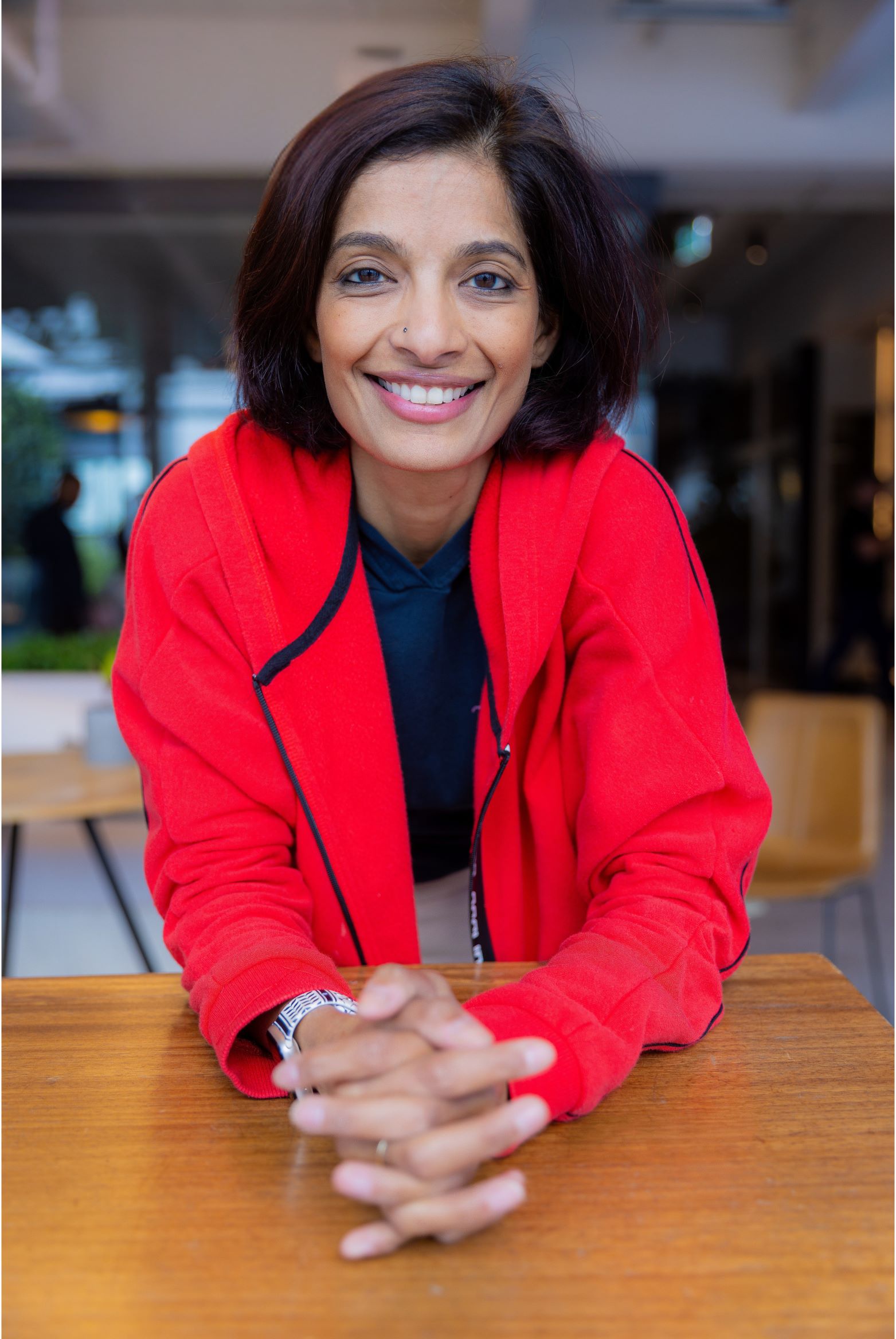
Arva Ahmed is the co-founder of Frying Pan Adventures, Dubai’s first food tour company, and a celebrated food explorer known for uncovering Dubai’s hidden culinary gems. Her expertise in the city’s diverse food scene has been featured in prominent publications such as CNN, Khaleej Times, BBC Travel, The Sun, The Independent and countless more. She also hosts Ditch the Silver on YouTube. Through her immersive tours and storytelling, Arva brings Dubai’s rich flavors and vibrant cultures to life.

